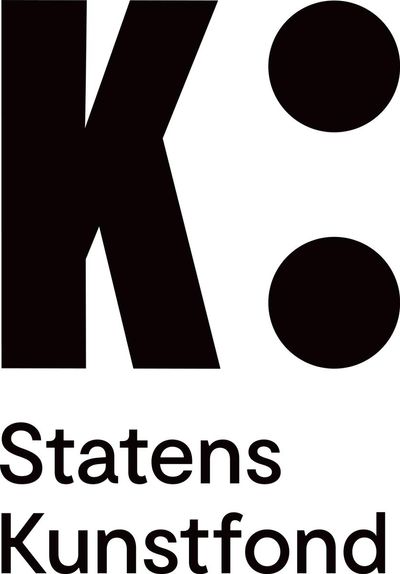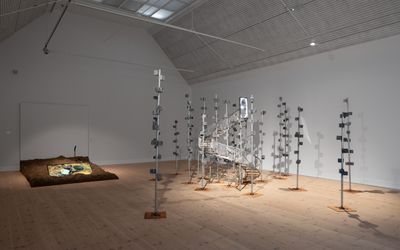La nudité de l'âme
–
Yvon Ngassam, Justine Gaga, Salifou Lindou, Stine Deja
–
Yvon Ngassam talks about his work The breath of our prayers speaks to souls.
La nudité de l’âme (The Nudity of the Soul) is a group show presenting works by Yvon Ngassam (1982, Cameroon), Justine Gaga (1974, Cameroon), Salifou Lindou (1965, Cameroon) and Stine Deja (1986, Denmark). Addressing questions of body culture and spirituality, the exhibition examines current issues that cut across cultures and national boundaries. It articulates the nudity of the body and soul, thereby delving into multiple issues: what makes us human? What constitutes each of us as individuals? How are the body and soul controlled or manipulated by others? And how are we connected across continents?
Danish artist Stine Deja contributes a thematically related work which helps to highlight differences in perspectives, but also the fundamental connection found between artists and people who, across cultures and national boundaries, explore humanity and contemporary life with openness and keen inquisitiveness.
In Cameroon, art, its infrastructure and development are seen as essential elements in securing the innovative social development in the country’s pursuit of greater economic stability and independence. These overall societal movements manifest as innovative and visionary art projects and art experiments. Such perspectives on the role of art and its potential for societal development offer a rich source of inspiration for the Danish and Western contemporary art scene. For audiences, the exhibition may offer an introduction to the burgeoning West African art scene, demonstrating new approaches to contemporary art.
About the works
Yvon Ngassam, The breath of our prayers speaks to souls, 2021
For the exhibition, Yvon Ngassam has created The breath of our prayers speaks to souls (2021), which is part sculpture, part video work. The sculpture draws inspiration from Buddhist meditation wheels, traditionally engraved with sacred mantras. As long as the wheel turns, the mantras are spread on the winds out into the world as positive energy. Instead of mantras, Ngassam has engraved the names of migrants who have died on their way to the West, either on their journey through the Sahara or by boat across the Mediterranean.
In his series of video works, which can be accessed via a QR code, Ngassam lets the migrants’ families speak: they express pain and suffering, anger and deprivation mixed with a clear certainty that the reunion they long for is impossible. The breath of our prayers speaks to souls lifts the migrants out of endless statistical and political strategies and turns them into fellow human beings with a name, a face and a family. For Ngassam, the work represents a sense of hope, of taking the first small steps in a journey towards reconciliation – reconciliation across cultures and between the deceased and the bereaved.
Justine Gaga, Redemption, 2021
For the exhibition, Justine Gaga created the sculptural installation Redemption (2021). The sculpture takes its thematic starting point in our performance culture’s focus on external beauty, which for Gaga also means that negative energy gets disseminated. The work consists of a series of metal poles carrying boxes, all arranged in a circle around a staircase that comes to an abrupt end in mid-air. According to Gaga, the installation’s totem-like structure can be seen as a mental place where spectators can set themselves free from all their own attitudes, faults and shortcomings without the fear of being judged by others.
For Gaga, Redemption is a study of self-optimisation and the challenges or doubts that arise when we try, as individuals – whether as a result of inner or outer pressure – to optimise our body and soul. With the work, Gaga explores what it does to the soul when we engage in a self-healing process or when we try to become one with ourselves.
Salifou Lindou, Universal Whirlpool, 2021
Salifou Lindou’s all-new sculpture Universal Whirlpool (2021) consists of a series of panels with windows. Stained plexiglass panes have been inserted in the windows, some of them carved as faces. With the work, Lindou explores how we interact with others when we are ‘face to face’ with them. In doing so, the artist invites the audience to discover and see themselves by recognising themselves in the faces of others. For Lindou, the game of recognising or discovering oneself through the encounter with another human being is an artistic method used to visualise his ideas about how we are connected as spiritual individuals who need to be met and seen by others.
Stine Deja, Cryptic Ruins, 2019
Stine Deja’s video work Cryptic Ruins (2019) is staged as a form of archaeological excavation in London. Inspired by the aesthetics of excavations by National Geographic, the piece was created by Deja by means of 3D technology. As the video pans across the excavation site, we are told what archaeologists believe the site was used for. Everything points to a so-called Body Temple. A temple for the discharge of energy, but the archaeologists are unsure about whether more than calories may have been sacrificed here – and to whom.
A present-day viewer will soon be able to identify this mysterious place as a perfectly ordinary gym. By applying a distant gaze on one of our major contemporary phenomena, Cryptic Ruins examines the ritualistic aspects of gym culture, its purpose and significance, and inquiries into why we are so obsessed with bodies.
About the project
La nudité de l’âme emerged out of the artist-run exhibition space and residency Bandjoun Station in Cameroon, where the Artistic Director of Kunsthal Aarhus, Jacob Fabricius, in the autumn of 2019 taught and discussed curatorial approaches and ideas with a team of twenty-five selected artists, mediators and curators.
It has long been the plan to bring the exhibition’s three Cameroonian artists to Denmark in order to meet artists and curators from the Danish art scene in connection with the exhibition’s opening. Due to the current Covid-19 restrictions, it has not yet been possible to realise this part of the project.
La nudité de l’âme was developed and curated by Viviane Maghela, Carine Djuide and Yvy Gisleine Chikou Mbianda in collaboration with Kunsthal Aarhus.
Curator Viviane Maghela is an entrepreneur within the fields of art and culture, and has worked as an independent advisor and curator for several years. Maghela is furthermore Artistic Director at the Douala Art Fair in Cameroun. Douala Art Fair was launched in 2018 with the mission to become a catalyst for the growing art economy in Africa.
Curator Yvy Gisleine Chikou Mbianda is qualified as a fashion designer and textile artist. She teaches at Institut des beaux-arts de Foumban (Foumban Institute of Fine Arts). The art academy in Foumban was established as part of a larger university reform in 1993 in Cameroun, and offers courses within visual art, architecture, drama and audio-visual arts.
Curator Carine Djuidje is the cultural mediator for Bandjoun Station. Bandjoun Station is a creative and non-profit workshop for artists, created by Cameroonian artist Barthélmy Toguo. The idea behind the project is to generate innovation and development within Cameroun through art. Bandjoun Station therefore acts as a networking site for both African and international artists.
Supported by






